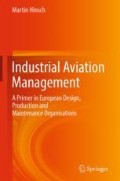Abstract
As soon as aircraft were handed over after production, it is to be ensured that they constantly remain in an airworthy condition during operation; this requires regular examination and maintenance activities. These activities may only be carried out by approved maintenance organisations according to EASA Part 145. This chapter deals with their structure and function in detail by first outlining the basics of aircraft maintenance.
Access this chapter
Tax calculation will be finalised at checkout
Purchases are for personal use only
Notes
- 1.
In addition to that, EN 9110 regulates setup and structure of maintenance organisations.
- 2.
See Chap. 5
- 3.
See IR Continuing Airworthiness Part 145 – 145.A.70
- 4.
See IR Initial Airworthiness Part 145 – 145.A.30 (a).
- 5.
See IR Initial Airworthiness Part 145 – 145.A.60
- 6.
Base maintenance is sometime also referred to as heavy maintenance
- 7.
See IR Continuing Airworthiness Part 66.
- 8.
All maintenance activities that are performed during daily flight operation, between two flights are thus also referred to as line maintenance.
- 9.
See AMC 145.A.10 as well as GM 66.A.20 (a).
- 10.
See IR Continuing Airworthiness EASA Part 145 – 145.A.65 (b) 3.
- 11.
According to IR Continuing Airworthiness Part M – M.A.306, the technical logbook is mandatory for all commercially used aircraft. In addition to flight information (time, distance, flight number, pilots) technical anomalies, malfunctions and error reports arising in flight are documented therein.
- 12.
The terms work planning, production preparation are used alternatively as well.
- 13.
For production planning basics, see Sect. 6.1
- 14.
See IR Continuing Airworthiness Part 145 – 145A.45 (e)
- 15.
See AMC 145.A.47 (a) 2.
- 16.
As far as possible, critical tasks are not to be performed during night shifts or at least not in highest fatigue periods (usually between 2 and 4 am), see AMC 145.A.47 (b)
- 17.
See IR Continuing Airworthiness EASA Part 145 – 145.A.47 (c).
- 18.
For details of maintenance staff qualification see Sect. 10.2.
- 19.
Sven Pawliska has been an engineering and production manager in various management positions at Lufthansa Technik AG for more than 15 years.
- 20.
See IR Continuing Airworthiness EASA Part 145 – 145.A.42 (d).
- 21.
See IR Continuing Airworthiness EASA Part 145 – 145A.35 (h).
- 22.
A deferral of defects is not unusual, however predominant in base maintenance for the end of a layover as not to putting the handover date at risk. Such unfinished work must be communicated to the aircraft operator before aircraft release, see IR Continuing Airworthiness Part 145 – 145.A.50 (c).
- 23.
See IR Continuing Airworthiness EASA Part 145 – 145.A.50 in connection with 145.A.70 and 145.A.45.
- 24.
See IR Continuing Airworthiness Part 145 – 145.A.55 (b) as well as Part M, M.A. 614 (B), subject to aviation legislation it suffices to submit copies to the holder. In practice, it is however common for the maintenance organisation to hand over the originals, retaining the copies.
- 25.
Engines and propellers are looked at in the next chapter.
- 26.
Scope of approval covers A, B and C-rating.
- 27.
In addition to maintenance, 145 organisations are entitled to manufacture a limited number of parts that are needed for work pending in own shops. For detailed information and restrictions, see IR Continuing Airworthiness Part 145 – 145.A 42 (c).
- 28.
See Kinnison (2004), p. 159.
- 29.
See IR Continuing Airworthiness Part 145 – 145.A 42 (d) and appropriate AMC.
- 30.
See IR Continuing Airworthiness Part 145 – 145.A 50 (d)
- 31.
The opposite of the closed-loop procedure is open-loop maintenance. However, the latter term is usually only used for the purpose of explicit distinction from the closed-loop procedure.
- 32.
For details on material scrapping, see Sect. 9.2.5.
- 33.
Pneumatic suspension is necessary to avoid damage to ball bearings.
- 34.
If the engine is held in reserve a longer time and manufacturer standards are hereby exceeded, a renewed preservation of the fuel system is necessary.
- 35.
Archiving maintenance records is regulated in the IR Continuing Airworthiness EASA Part 145 – 145.A.55 and the associated Guidance Material.
References
European Commission: Commission Regulation (EC) on the continuing airworthiness of aircraft and aeronautical products, parts and appliances, and on the approval of organisations and personnel involved in these tasks [Implementing Rule Continuing Airworthiness]. No. 1321/2014, 2014
European Aviation Safety Agency – EASA: Acceptable Means of Compliance and Guidance Material to Commission Regulation (EC) to the Annexes to Regulation (EU) No 1321/2014 – Issue 2 [Implementing Rule Continuing Airworthiness]. ED Decision 2015/029/R. AMC/GM
Kinnison, H.A.: Aviation Maintenance Management. New York, 2004
Author information
Authors and Affiliations
Corresponding author
Rights and permissions
Copyright information
© 2019 Springer-Verlag GmbH Germany, part of Springer Nature
About this chapter
Cite this chapter
Hinsch, M. (2019). Maintenance. In: Industrial Aviation Management. Springer, Berlin, Heidelberg. https://doi.org/10.1007/978-3-662-54740-3_8
Download citation
DOI: https://doi.org/10.1007/978-3-662-54740-3_8
Published:
Publisher Name: Springer, Berlin, Heidelberg
Print ISBN: 978-3-662-54739-7
Online ISBN: 978-3-662-54740-3
eBook Packages: EngineeringEngineering (R0)

